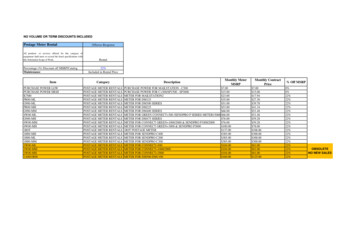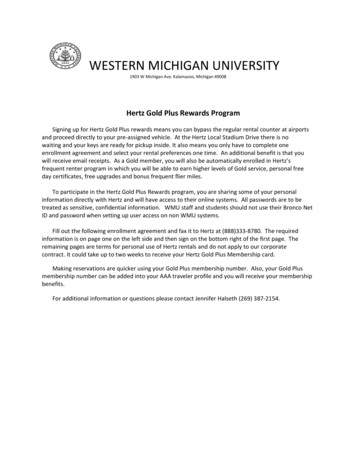
Transcription
The United RentalsGuide to Trench SafetyProtect workers through knowledge and actionThe United Rentals Guide to Trench Safety 1
ContentsChapter 1:A Matter of Life and Death3Chapter 2:The Role of the Competent Person6Chapter 3:Choosing the Right Trench Protective System9Chapter 4:When Do You Need a Professional Engineer?11Chapter 5:Myths about Protective Systems13Chapter 6:When Is a Trench a Confined Space?16Chapter 7:Creating a Trench and Excavation Safety Culture17The United Rentals Guide to Trench Safety 2
1.A Matterof Lifeand DeathEric Giguere will never forget the terror he felt whena trench cave-in buried him 6½ feet underground.“ I couldn’tsee,I couldn’tmove.“It was pitch black. I couldn’t see, I couldn’t move.I was completely helpless. Every time I would exhale,the dirt would get tighter and tighter. It crushed mychest; I couldn’t breathe. I was suffocating,” herecalled. “I knew I was going to die right thenbecause we didn’t follow safety procedures.”Giguere understood that his company should haveinstalled a trench box or sloped the sides of thetrench when the excavation went deeper than 5 feet.But he didn’t raise any objections that day. Thatlapse, and his company’s failures, nearly costGiguere his life.But he got lucky: His coworkers were able to dig himout, perform CPR and get him to a hospital quickly.He spent 36 hours on life support before beginninghis difficult 2½-year recovery. He still has nightmaresabout the earth caving in.Giguere was lucky to survive a trench collapse.Many others don’t. Sometimes not evenimmediate rescue can save the victim.The United Rentals Guide to Trench Safety 3
Working in trenches and other excavations is one of construction’smost dangerous activities. According to OSHA, the fatality ratefor excavation work is 112 percent higher than the rate forgeneral construction.Trench collapses are rarely survivable, since one cubic yardof soil can weigh as much as a small car.Trenching Injuries & 08215211 132311 160TRENCH-RELATED FATALITIESTRENCH-RELATED REPORTED INJURIESSource: Bureau of Labor StatisticsTrench cave-infatalities reacheda high in 2016when 36 workersdied —more thandouble theaverage for theprevious fiveyears. The nextyear, 23 workersdied.Most trench accidents are preventable by following proper safetyprecautions and regulations.A trench doesn’t have to be deep to be dangerous.According to OSHA, 72 percent of trench fatalities occur intrenches less than 9 feet deep. Cave-ins are typically fataleven if the worker is not completely buried.The United Rentals Guide to Trench Safety 4
The importance of safety76%of trench fatalitiesoccurred when noprotective systemwas used.Source: OSHA“I’ve personally seen too many trenches that arenot made safe, and too often, safety procedures,inspections and proper protective systems aredisregarded for ‘production’ motives,” said BlakeSmith, sales and marketing director for UnitedRentals Trench Safety.Some contractors skip the installation of atrench protective system because of time orcost pressures. But that decision can backfire.If a cave-in occurs, the project timeline willstretch because an investigation will shut the sitedown. Costs will also increase — just considerthe OSHA fines and the increased insuranceexpenses, not to mention any lawsuits. A trenchcollapse could also ruin a company’s reputationand lose it business.The importance of complianceOSHA has proposed some big fines in recent years against companies accused ofviolating excavating and trenching rules.PROPOSED PENALTIESVIOLATIONDATE 1,475, 813Boston contractor — two workers killed in atrench collapse10/2016 714,142Missouri plumbing contractor — worker killedin trench collapse and did not make necessaryimprovements in operation12/2016 454,750North Dakota excavation contractor — exposingemployees to trench hazards while installing watermetering pits and lines4/2018 271,606Florida utilities contractor – worker injured whenwater accumulated in trench; company did notprovide adequate trenching protections8/2017The United Rentals Guide to Trench Safety 5
2.The Role of theCompetent Person“The single most important measure for preventing cave-ins when working in trenches isdesignating a competent person and making sure that person is adequately trained,” saidJoe Wise, regional customer training manager, Trench Safety, at United Rentals.OSHA regulations require every excavation to have a competent person in charge ofoverseeing all aspects of the excavation.What is a competent person?OSHA defines a competent person as “one who is capable of identifying existing andpredictable hazards in the surroundings or working conditions which are unsanitary,hazardous, or dangerous to employees, and who has authorization to take promptcorrective measures to eliminate them.”The responsibilities of the competent person include: Determining the best type of protective system for the excavation, accounting for factors such as depth, soil type and adjacent structures and surface encumbrances. Inspecting the excavation and protective systems daily and after weather events, suchas rains or high winds. Identifying existing and predictable hazards and taking prompt actions to eliminatethese hazards.The United Rentals Guide to Trench Safety 6
Sample trench inspection checklist itemsIs there appropriate means of access and egress?Are ladders properly placed?Does the protective system comply with OSHA requirements?Has the atmosphere been tested?Are workers wearing the appropriate PPE?Is appropriate fall protection in place?Are workers protected from falling items, suspended loadsand loose gravel?Is spoilage more than 2 feet from the edge?Have the conditions changed since the last inspection?Is water present that needs to be controlled through dewateringoperations?Experience and training both countWhen an employer designates someone a competent person, it is putting great trust in thatperson and expecting him or her to shoulder a serious responsibility. Choosing the rightperson is essential. Years of experience with different trench situations is helpful, andappropriate training is critical.OSHA doesn’t spell out specific training requirements, only the type of knowledge theperson needs. For example, for trenches, the competent person must be knowledgeableabout soil analysis, the use of protective systems and the requirements of the 1926 subpartP standard.The United Rentals Guide to Trench Safety 7
Training should be ongoing.Protective solutions have seensignificant advancements, and thecompetent person may not be upto speed if training has not beenkept current.If the competent person findshimself in a situation in whichhe’s unsure of the best protectivesystem for the job, it’s importantto seek advice. United RentalsTrench Safety can offer guidanceby phone or during a jobsite visit.No one is competent at everything.There’s a misunderstanding at some companies thatan individual who is designated a competent personfor one activity is automatically a competent personfor another. A person might know everything theyneed to know about trench safety, for example, butnot be qualified to inspect scaffolding.United Rentals is the largest provider oftrench safety training programs, with coursesincluding Excavation Safety Training forCompetent Persons.The United Rentals Guide to Trench Safety 8
3.Choosing the RightTrench Protective SystemOSHA regulations for excavation and trenching operations, covered in Standard 1926Subpart P, require contractors to use a protective system any time a trench is 5 feetdeep or greater.There are several types of protective systems: Benching – excavating trench sides to form horizontal levels or steps Sloping – excavating sides to angle away from the excavation Shoring – installing supports, such as a hydraulic strut system Shielding – installing a trench box or similar structureAny protective system used must adhere to the OSHA charts (found in Appendices B,C & D of OSHA’s 1926 Subpart P) or the manufacturer’s tabulated data or be designedby an RPE. The competent person must review the OSHA charts or tabulated data orconsult with a RPE to ensure that the desired system will satisfy all requirements.The United Rentals Guide to Trench Safety 9
To determine the right type of protective system for a particularjob, contractors should consider these five factors:1.2.3.4.5.The type of soil in the excavation area. OSHA usesthese classifications: Stable rock Type A – cohesive, undisturbed (i.e. clay and clayblends) – high compressive strength Type B – cohesive, but disturbed, or with cracks –medium compressive strength Type C – least stable, granular (i.e. sand or gravel),and/or any soil that has water seeping into it.The purpose of the excavation. While cross-bracesmight work when you’re installing a long, linear run of watermain, they will be in the way if you’re excavating in order todrop in a large, pre-cast structure.The width, depth and length of the excavation.Shoring and shielding is available in a wide variety of sizesand configurations to fit the dimensions of any excavationor trench.Other site issues. Are there adjacent structures?Surface encumbrances? Groundwater problems? Overheadobstructions?The area you have to work in. Since sloping andbenching systems require a mass excavation of dirt, they’renot usually good choices for a downtown location crowdedwith roads and buildings.The United Rentals Guide to Trench Safety 10
4.When DoYou Need aProfessionalEngineer?Some excavations are relatively straightforwardand simply involve choosing the right protectivesystems. The OSHA charts allow for sloping,benching, timber and aluminum hydraulic protectivesystem configurations up to a maximum depth of20 feet.But any deviation from the OSHA charts requireswritten approval by a registered professionalengineer (RPE). Deviations may include excavationsdeeper than 20 feet, and, for sloping, any designsteeper than what’s allowed.Using tabulated dataManufacturer’s tabulated data are the tables andcharts, approved by an RPE, that are used todesign and construct a protective system. Theyalso provide guidelines and usage limitations to themanufacturer’s equipment.The United Rentals Guide to Trench Safety 11
Some manufactured protective systems are rated for working in depths of over 20 feetas indicated by its tabulated data, so an RPE is not required. However, even if working atdepths of less than 20 feet, an RPE may need to get involved if the design parameters ofthe protective system will be exceeded.When the tab data is not followed, at any depth, for any reason, an RPE must allowapproval. Examples of this may include end loading and extraordinary surcharges.No tab data? You need an RPEWhen the materials to be used for a protective system have no tabulated data, OSHA allowsa design from an RPE. These materials include cantilevered steel sheeting and sheetingwith welded bracing. The engineer is required to evaluate the soil, choose the section andlength of sheet, choose the location and section of beam and provide the welding detail.Engineering for this form of protective system is required at any depth.Tab data cautionsCaution 1: Don’t assume tab data are interchangeable just because two pieces ofequipment are similar in shape and size. Each manufacturer has a set of tab dataspecific to each type and model of protective equipment. Some equipment, likesteel shields, has specific tab data tied to it by a serial number. Other equipment,like aluminum hydraulic shores, is addressed by a more generalized document thatcovers a variety of sizes of the same kind of equipment.Caution 2: If the tab data don’t address a particular situation, don’t assume thatany solution you devise is acceptable. 1926.652. (c)(2)(ii) states that deviations fromthe tab data will be allowed only if the contractor has written permission from themanufacturer or an RPE.The United Rentals Guide to Trench Safety 12
5.Myths aboutProtective SystemsDon’t be fooled by any of these common misconceptions about trench protective systems.Myth:Only one type of protective system can be used for a particular job.Fact:OSHA doesn’t require the use of a particular system in a given situation. Thecompetent person can choose the system that makes the most sense.Myth:Trench boxes can prevent cave-ins.Fact:Trench boxes aren’t designed to shore an excavation’s walls. They’re designedto protect workers from the pressure and weight of soil in the event of a cave-in.The United Rentals Guide to Trench Safety 13
Myth:You have to use plywood, steel or other sheeting behind aluminum hydraulic shores.Fact:If you don’t have sloughing or raveling of the soil, you may be able topressurize the hydraulic shores right against the dirt walls. You’d typically usethis on a short-term excavation and with more stable soil types. Follow themanufacturer’s guidelines.Myth:You can use just one aluminum hydraulic shore for a protective system.Fact:You can never use just one shore. In hydraulic shoring applications,manufacturer’s tabulated data requires a minimum of three consecutive shores.For excavations that are too short to place three or four shores at the requiredspacing, two shores can be used, as long as they are placed at the requiredspacing and are within 2 feet of each end of the excavation.The United Rentals Guide to Trench Safety 14
Myth:You’ll always be compliant if you use the depth ratings and spacing numbers on thetabulated data.Fact:The tabulated data “assists” the competent person, but he or she may need toconsider other factors that could require adjustments to those numbers, such asheavy surcharges or water conditions that impact soil conditions and increasehydrostatic pressure.Myth:If the competent person feels that something will work as a protective system, we canuse it.Fact:The competent person has to adhere to OSHA standard 29 CFR Part 1926, SubpartP. The burden is on the competent person to prove that any protective system willfunction according to the requirements of the standard.The United Rentals Guide to Trench Safety 15
6.When Is a Trencha Confined Space?Open trenches and excavations such as building foundations are regulated under OSHA’sexcavation standard, 29 CFR Part 1926, Subpart P. But there are times when undergroundexcavation projects require workers to enter a structure such as a precast pipe, manholeor vault. These structures are subject to OSHA’s confined space rules because they arelarge enough for a person to enter but limit or restrict means of entry or exit and are notdesigned for continuous occupancy by a worker.Confined spaces in construction are regulated by OSHA 1926 Subpart AA. The standardrequires the jobsite to have a competent person who can identify confined and permitrequired spaces and can evaluate those spaces, including identifying physical hazardsthat must be eliminated or controlled and performing atmospheric testing if necessary.If an actual or potential physical or atmospheric hazard exists that can’t be eliminated orcontrolled, the space is considered a permit required confined space.The OSHA standard for confined spaces in construction is very detailed. The agencyhas provided these resources to help contractors understand them: Frequently Asked Questions Protecting Construction Workers in Confined Spaces: Small Entity Compliance Guide Confined Spaces in Construction: Sewer Systems Confined Spaces in Construction: PitsThe United Rentals Guide to Trench Safety 16
7.Creating aTrench andExcavationSafety CultureNo company wants to experience anincident resulting from a trench orexcavation collapse. Fortunately,these incidents are preventable. Thebest way to prevent a trench collapseor cave-in is by clearly defining andexecuting a trench safety program aspart of a strong safety culture.A world-class safety culture features:A written company safety policy.A good policy thoroughly outlinesresponsibilities and practices to befollowed.Effective, ongoing safety training.One-time training is not enough.Reinforce safety messages duringsafety meetings, toolbox talks, etc.,and send workers for formal trainingwhenever necessary. Trench safetysolutions and protective equipmentevolve, so make sure your trainingkeeps up.A demonstrated commitment tosafety from management. FromCEO to field supervisors, managersshould show by their words andactions that they value the safetyof the workers on the jobsite aboveeverything else.Reminder: Provide training ina language and vocabulary theworker understands.The United Rentals Guide to Trench Safety 17
Worker involvement. “Involving workers in the creation andimplementation of a company’s safety program goes a long waytoward getting them to buy into the value of the safety practices,” saidJames A. Dorris, vice president of health, safety and environment forUnited Rentals.Stop-work authority. Give workers not only the authority but theresponsibility to stop work if a task or situation presents a danger tothemselves or others.The Pre-Job BriefingDevelop a pre-job briefing checklist for trench work. Hold these briefingsdaily before work begins, and use them as a chance to discuss hazards,hazard mitigation, PPE needs and more.Working with subcontractorsWhen you’re working with subcontractors (and their subs), theirunsafe behaviors in trenches and other excavations could affect thesafety of all the workers. What’s more, if your employees see thatsubs aren’t following the rules, they’re less likely to believe that youtake those rules seriously.To help ensure that your subs are on board with trench andexcavation safety: Make sure every subcontractor on your jobsite understands andcomplies with relevant safety rules and regulations. Prequalify subs by researching their experience modification rateand their OSHA 300 and 300A records. Check references, and ask specifically about safety. Ask them to outline their safety policies, the safety proceduresthey follow for trenching and excavation work and the methodsthey use to ensure that workers comply.The United Rentals Guide to Trench Safety 18
Make the investment in worker safetyNo construction worker enters a jobsite excavation thinking that this will be theday the earth caves in.“Too often, workers doing this type of underground work think an accident won’t happento them,” said Blake Smith. And it shouldn’t. Despite the alarming rise in trench fatalities,most trench accidents are preventable.When an accident does happen, the impact is rarely minor.“In circumstances where a worker encounters a life-changing injury or fatality, the costgoes beyond citations, fines and court settlements,” said Smith. “Families are left with theburden to move forward with their loss to cope beyond their loved one’s injury or death.”Every company faces pressure to complete increasingly complex jobs within increasinglychallenging timelines. But shortcuts can backfire, costing time, money, and sometimes,lives.Trench work can be dangerous. But if you take the necessary precautions to make it less soand train your workers to do the same, projects can get done more efficiently and safely.The United Rentals Guide to Trench Safety 19
With more than 90 trench safety branches andthe largest fleet of shoring and undergroundexcavation rental equipment in North America,United Rentals can help you find the right solutionfor your excavation needs.United Rentals is also the largest provider oftrench safety training programs. Training is availableonline, onsite or at one of our store locations.The United Rentals Guide to Trench Safety 20
The United Rentals Guide to Trench Safety 2 Contents Chapter 1: A Matter of Life and Death 3 Chapter 2: The Role of the Competent Person 6 Chapter 3: Choosing the Right Trench Protective System 9 Chapter 4: When Do You Need a Professional Engineer? 11 Chapter 5: Myths about Protective Systems 13 Chapter 6: When Is a Trench a Confined Space? 16 Chapter 7: Creating a Trench and Excavation .










